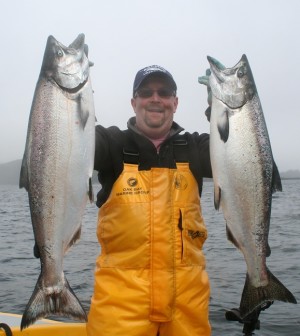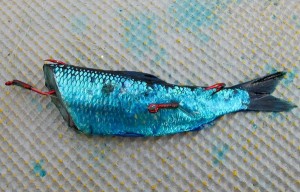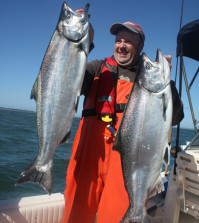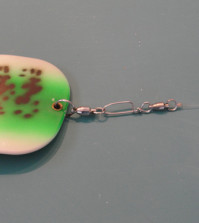Motor Mooching

When it comes to saltwater salmon fishing, there’s usually two distinguished groups of fishermen, those that troll and those that mooch. Growing up as a kid and well into my 20’s I loved to mooch. The constant contact with rod and reel, the ability to be “in control” of every aspect of your rig, and most of all, the feel of the take. As I began to meet other fishing buddies who were downrigger users and preferred to troll, well I was forced to fish their method on their boats, they would fish mine on my boat.
Now move forward to my 40s and with my association with Salmon University, I can see the benefits to both techniques and most times it comes down to personal preference. Trolling covers more water to find the fish, while mooching you can stay on top of the fish once found. Both can be extremely effective and offers enjoyment in whichever your preferred method. If only there was a method that combines the best of both worlds… and there is! Essentially motor mooching is a cross between mooching and trolling. The mooching aspect utilizes the motor to set the depth, while the motor also sets the speed at which we cover the water, trolling.
So here’s how we get started. A nice mooching rod helps. I use a Fetha Styx SH-1045 rated 10 – 20lbs, medium heavy power with moderate action. What I like about this rod is the butt section has plenty of power for the Chinook, but has the moderate action required so when the salmon takes the bait they don’t feel the rod – but you’ll feel the fish. I like to match that up with a Daiwa Luna 300 which has as smooth of drag as you’ll ever feel. Load it up with 25lb mono and you’re set on the business end. Now most of you know from my steelhead fishing that I’m a huge PowerPro fan – but when it comes to motor mooching I prefer the “give” of mono, again so the salmon does not detect they’re hooked until you set it.
Now that we have our rod and reel it’s time to put your presentation together. I start with a sliding weight holder slipped over the main line. I then tie on a high quality ball bearing swivel. Don’t go cheap on the swivel either, it very important to not only keep your presentation spinning, but also so as it spins it doesn’t twist the line. If fishing for Chinook, I’ll use a 6ft leader tied with 30lb Maxima Ultra Green leader material. This is backwards from river fishing where you want the leader smaller than the mainline. With Chinook I’m not worried about breaking off the fish, that’s what we have a drag system for, I’m worried about all those sharp teeth nicking the line which leads to a lost fish. I tie my own leaders using high quality barbless hooks, matching the size of hooks to the herring I’ll be using. Owner or Gamakatsu hooks are generally those you’ll find me using. And don’t forget that sliding weight holder, to that attach anywhere from a 2oz to 8oz cannon ball lead depending on the line angle you want and how fast you want it to drop during a free fall. Most often for Blue label I’ll use 6oz – Green label I’ll use 4oz, and Red label or spinners I’ll use 2oz. I’ll only use 8oz when I’m fishing below 80ft of water.
 Herring is the bait you’re going to want to use. Cut plug herring, using the Salmon University brine recipe is the top producer for me. Whole herring or herring spinners are also effective, but I can usually control the spin better with a cut plug. What I’m looking for is a tight spin, like a drill bit, and a fast one at that. We’ve all heard the theory that a slow roll is preferred by Chinook – I don’t buy into that theory. I want my herring spinning fast and tight all the time. After rigging up a double hook setup with a cut plug I always watch the spin in the water before letting it down. If it’s not perfect, I re-set the hooks. If it’s still not perfect I’ll put a new herring on. We need to maximize our effectiveness on the water and it all starts with the herring.
Herring is the bait you’re going to want to use. Cut plug herring, using the Salmon University brine recipe is the top producer for me. Whole herring or herring spinners are also effective, but I can usually control the spin better with a cut plug. What I’m looking for is a tight spin, like a drill bit, and a fast one at that. We’ve all heard the theory that a slow roll is preferred by Chinook – I don’t buy into that theory. I want my herring spinning fast and tight all the time. After rigging up a double hook setup with a cut plug I always watch the spin in the water before letting it down. If it’s not perfect, I re-set the hooks. If it’s still not perfect I’ll put a new herring on. We need to maximize our effectiveness on the water and it all starts with the herring.
I always start with the motor in gear so as I’m letting the line out the herring spins, plus it has less of a chance of tangling up which occurs often by those that mooch and let their lines free fall straight down. Just like with downrigger fishing, I like to stagger my lines until we find fish. A good starting point is 30ft, 50ft and 70ft. As the motor is in gear the line is further back then it is deep. Once all the lines are in the water is when we actually start motor mooching. The idea is to put the motor in neutral which allows your presentations to fall, as in regular mooching. But, prior to your gear becoming straight up and down, you put it in gear again which not only cause the herring to spin faster, but it also rises when doing so. So each time you engage the motor the herring spins faster and rises, when it’s in neutral it falls, thus covering all depths of water.
I love to hold the rod, but with this technique you’ll achieve more solid hookups if you put the rod in a rod holder. When the motor is in gear, wait until the rod doubles over to set the hook. If you’re in neutral, let the fish take it, even “feed” it some line if you need to until the fish is solid on the other end, then put it to em!
Motor mooching is a very effective way to cover ground and cover a large portion of the water column. Give it a try, I’m sure you’ll love it.








